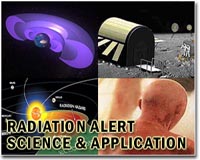 |
Los Angeles (AFP) March 17, 2011 The United States announced Thursday it was boosting radiation monitoring on the west coast and Pacific territories, as it seeks to allay public concern about fallout from Japan. While insisting the risk to the United States is minimal, the Environmental Protection Agency (EPA) sent extra monitoring units to Alaska, Hawaii and Guam to boost an existing network of 100 air surveillance sites around the country. No increase had yet been detected, EPA said, although nuclear experts predict that low levels of radiation could be detected on the coast of California as early as Friday. "We do not anticipate seeing any levels of radiation in the US that have potential public health impact," said Jon Edwards, director of EPA's radiation protection division. Concerns over radiation from Japan's Fukushima nuclear power plant have been keenest in the western mainland states of California, Oregon, and Washington State, as well as Alaska and Hawaii. California's Emergency Management Department noted that California could detect heightened radiation as early as Friday. The forecast, by the UN's Comprehensive Nuclear Test Ban Treaty Organization, "indicates that monitoring stations in Southern California may be able to detect extremely low levels of radiation late Friday," it said. "This projection is based on patterns of Pacific winds at the time of the forecast and is likely to change as weather patterns shift," it added. It added that if a radioactive plume moved across the Pacific at its current strength, "it may not be detectable and would pose extremely minor health consequences even if trace amounts are detected." Hawaii is some 4,000 miles (6,500 km) from Japan, while the California coast is up to 5,500 miles (8,800 km). California's emergency department also noted that the US Nuclear Regulatory Commission expects no harmful levels of radioactivity to reach the United States from Japan "due to the significant distance between the two countries." President Barack Obama also sought to reassure Americans Thursday, saying: "We do not expect harmful levels of radiation to reach the United States, whether it is the west coast, Hawaii, Alaska or US territories in the Pacific." The main US manufacturer of potassium iodide pills, which can protect against the effects of radiation, ran out of supplies within hours of the Japanese earthquake, according to the company's boss. California health director Howard Backer said the public should get things in perspective. "We understand people's concerns .. Radiation is scary stuff. It can have devastating effects in high doses, but we also need to remember that radiation is part of our natural environment," he said. "We do not anticipate any amount of radiation that would cause any health effects," he said. "We're 5,000 miles away, which would have a major dispersal effect on any radiation," he added in a conference call with reporters.
Share This Article With Planet Earth
Related Links Space Technology News - Applications and Research
 US admiral 'optimistic' on Japan nuclear risk
US admiral 'optimistic' on Japan nuclear riskWashington (AFP) March 17, 2011 A top US officer voiced cautious optimism Thursday that a meltdown at Japan's quake-hit nuclear plant could be averted and said the military stood ready to bolster its aid in the crisis. Admiral Robert Willard, who is overseeing American military assistance after Japan's earthquake and tsunami, said 450 radiological and disaster specialists were awaiting orders to deploy as Japanese teams tr ... read more |
|
| The content herein, unless otherwise known to be public domain, are Copyright 1995-2010 - SpaceDaily. AFP and UPI Wire Stories are copyright Agence France-Presse and United Press International. ESA Portal Reports are copyright European Space Agency. All NASA sourced material is public domain. Additional copyrights may apply in whole or part to other bona fide parties. Advertising does not imply endorsement,agreement or approval of any opinions, statements or information provided by SpaceDaily on any Web page published or hosted by SpaceDaily. Privacy Statement |